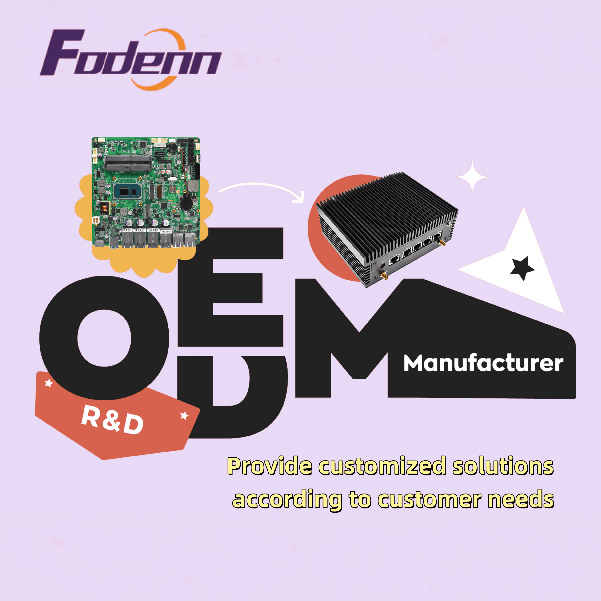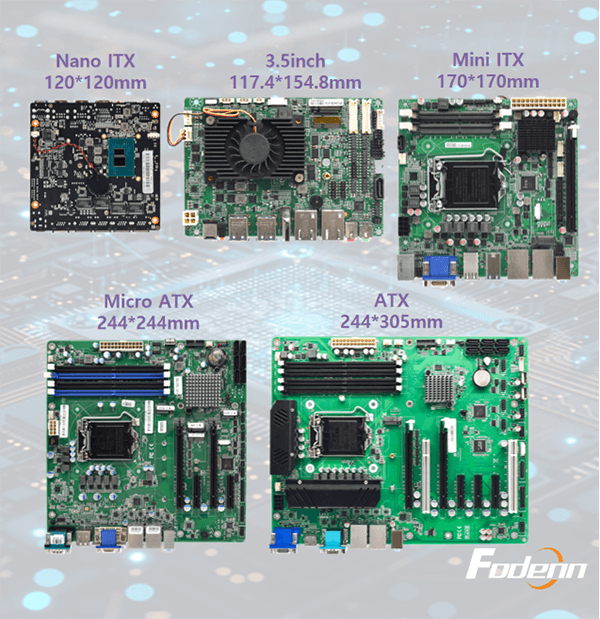What's the Best Motherboard Size for Industrial Project Use?
Nov 02, 2024
With the development of emerging technology industries such as industrial automation, industrial motherboards are the backbone of any industrial computing system, and choosing the right form factor motherboard is crucial for ensuring the performance, reliability, and longevity of your equipment. The selection process involves considering the form factor, extensibility, size, and cooling requirements, as well as the specific application needs. So when you ask "Which size motherboard is more suitable for my project application design?" The answer to this question is not one-size-fits-all, as it largely depends on the specific requirements and constraints of your project. Here are some guides to help you determine the most suitable industrial motherboard size for your application.
Factors to Consider
1. Space Constraints: The surface dimensions of your project's products will be the primary factor. If you're working on a compact device or an embedded system with limited space, smaller form factors like Mini ITX (170*170mm), Nano ITX (120*120mm), Pico ITX (72*100mm), or even COM Express modules might be more appropriate. For larger industrial systems or those requiring more expansion slots, ATX (305*244mm)or Micro-ATX (244*244mm) motherboards could be the better choice.
2. Performance Needs: The processing power and memory capacity required by your project application will also influence your choice. Higher performance applications, such as those involving heavy data processing or complex computations, may necessitate a larger ITX motherboard / ATX motherboard that can accommodate more powerful CPUs and a greater amount of RAM.
3. Expansion and Connectivity: Consider the number and type of peripherals you plan to connect and install. Larger motherboards typically offer more expansion slots (PCI, PCIe) and a wider array of built-in connectors for various interfaces (USB, SATA, COM ports, etc.). If your application requires a high degree of connectivity, a larger motherboard may be more suitable.
4. Power Requirements: The power consumption of your embedded system can also dictate the motherboard size. Larger motherboards can support more power phases and higher wattage, which may be necessary for certain high-performance components.
5. Thermal Management: Heat dissipation is also crucial in industrial applications. Larger motherboards generally have more space for heat sinks and better airflow, which can help maintain optimal operating temperatures.
6. Cost: Budget is always a consideration. Smaller form factor motherboards can be more cost-effective, but they may also have limitations in terms of performance and expandability.
Common Form Factors
Mini-ITX: Ideal for small form factor applications where space is at a premium. They offer a good balance between size and performance, making them suitable for applications like kiosks, digital signage, and small form factor PCs.
Micro-ATX: A step up from Mini-ITX, Micro-ATX motherboards provide more expansion options and better cooling capabilities. They are often used in mid-sized industrial PCs and systems where a bit more room is available.
ATX: The standard size for desktop computers, ATX motherboards offer the most room for expansion and high-performance components. They are suitable for server rooms, high-performance workstations, and systems that require multiple expansion cards.
COM Express: A compact module suitable for highly integrated and space-constrained applications. It's often used in embedded systems where the CPU, memory, and some I/O are integrated into a single module.
Small Form Factor MotherboardFor the heat dissipation of small form factor motherboards, the industry has developed a variety of innovative methods to cope with space constraints and heat dissipation needs. Here are some effective heat dissipation solutions:
1. Enhanced air cooling: Some small form factor motherboards use special air cooling designs, such as using ultra-thin and efficient heat sinks and high-speed fans to increase heat dissipation capacity. For example, by adding ultra-thin heat sinks and fixing them with electrical tape, the temperature is effectively reduced.
2. Combination of heat spreader and heat pipe: In the CPU radiator design, the combination of heat spreader and heat pipe can improve the heat dissipation efficiency. By improving the heat pipe layout, such as sawing off the edge of the heat pipe without affecting the efficiency, the heat dissipation performance can be increased and optimized obviously.
3. Motherboard miniaturization: Through high-density layout and miniaturization design, more heat dissipation space can be created in small devices such as mini PCs, and laptops. For example, the heat dissipation effect is improved through dual fans and dual heat pipe cooling systems.
4. M.2 SSD dedicated cooling: For the cooling of high-speed M.2 SSDs, motherboard manufacturers like Fodenn have launched a variety of cooling solutions, including water cooling, SO DIMM.2 memory radiators, 3D printed M.2 fan brackets, and double-layer heat sink designs to improve the cooling efficiency of SSDs.
5. Downward-blowing CPU radiators: For ITX and ATX motherboards, compact downward-blowing CPU radiators can be used. These radiators usually have built-in heat pipes and thin designs to adapt to the height restrictions of small chassis.
These innovative methods demonstrate the diversity and progress in the cooling design of small motherboards, allowing small devices to effectively manage heat while maintaining compact size, ensuring performance and stability.
The choice of form factor motherboard size for your project application design should be based on a careful assessment of your project's specific needs. Consider the space available, the performance required, the number of peripherals you need to support, power and thermal management, and your budget. By carefully considering the factors mentioned above, you can ensure that your system is equipped to handle the demands of your specific application while providing a platform for future growth and technological advancements.
Remember, the world of industrial motherboards is constantly evolving, with new form factors and technologies emerging to meet the demands of an ever-changing landscape. As a designer, it's essential to stay informed about these developments to make the best choices for your projects. As a professional designing and manufacturing team, Fodenn has been committed to the research and development of many kinds of industrial motherboards for many years. To find the professional solutions you need for your next construction project, send your requirements and reach out to our team directly to learn more.
Read More

